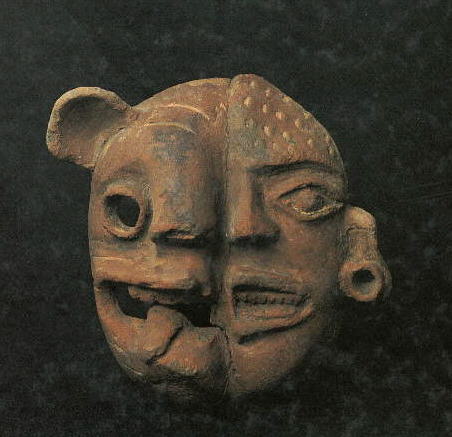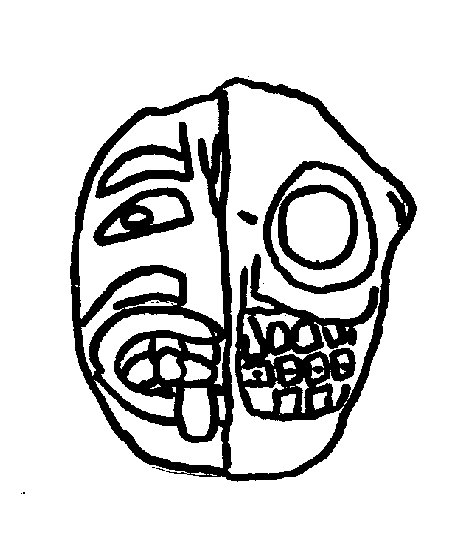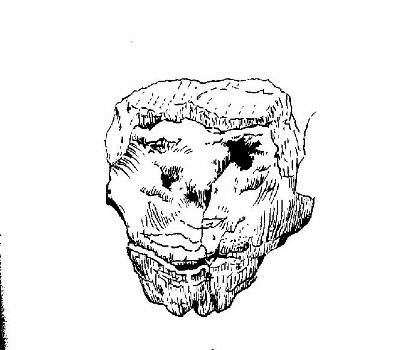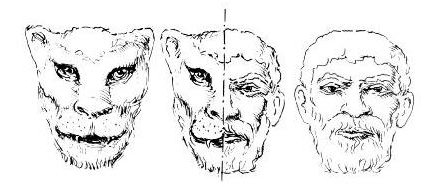
The two zooanthropomorphic ceramics, which I am examining, are considered "masks", but they are not "masks" used to disguise oneself, although they may derive from "real masks" such as ones found in wood, similar types, in equatorial Africa.

A mask representing a face half human with hairdress, elliptical eye with central pupil, ear with pierced lobe, nose and open mouth; the other half represents a feline or dog with round pierced eye. Height 22.8 cm, width 20 cm. (Central Mexico, 3rd century BCE - 3rd century AD. Upper Pre-Classical Period). (International Museum of Ceramics in Faenza. Italy)

The other mask represents a face for half of a living man, and the other half a skull. The eye and the orbital zone are pierced. Height cm. 8.5, width cm. 7.3. (Tlatilco, Mexico, middle Pre-Classical Period) (National Museum of Anthropology of Mexico City)
This mask is described in the Museum like characterization of the dualism life - death.
The affinities between the two masks are constituted from the representation of the tongue outside from the mouth. In the head of animal (Fig. 1) the pointed tongue seems to me human, while in the human head (Fig. 2) the tongue seems to me of dog, in how much it has equal width for all the length, and protrudes touching the chin. In these half faces (for the tongue) there is a mix animal - man (Fig. 1), and man - animal (Fig. 2). Moreover, in both the masks, the tongues are on the left. This may be a coincidence, but it may mean something if there are more of them, and all with the tongue on the left. In Tibetan ethnography, the tongue out of the mouth, and the hands forward with the thumbs raised, is a form of greeting. So, among the interpretations of these masks, as concerns the tongue out of the mouth, we will also have to consider the "greeting".
The half head (Fig. 2) representing the skull, and representing the death, to me does not represent a human skull, but a mammal skull. I deduce this from the protuberance to the right in the mammalian ear area, and the large orbital area. However, teeth have human features, and therefore, it can be considered the skull of a "humanized animal".
These types of zooanthropomorphic depictions fall within bicephaly. Two-faced depictions are found throughout all times, and in almost all the world places. Two-faced anthropomorphic depictions are in greater numbers and generally unite two heads looking in opposite directions, the best known of which is two-faced Janus.
The origin of the bicephaly is in the lower Paleolithic, and continues uninterruptedly until the historical times. The bicephaly , in the Paleolithic, is found only in the sculpture of western Europe, because there were made intense researches, but probably it is present also in other continents.
The two-faced zooanthropomorphic Paleolithic sculpture joins at the nape an animal head to a human head, generally looking in opposite direction. Others, very rare, like that one that I introduce here, join half animal head to half human head with forward look, like the two Mexican masks.
This sculpture has been found by Prof. Leslie Freeman of the University of Chicago and by Spanish archaeologists in El Juyo, Santander in Spain (Now preserved in the Museum of Altamira). The lithic sculpture of El Juyo represents in a some rough way half human head with beard and whiskers to half feline head.


It is cm 35 height, wide cm.32,5, thick cm.22,5. The sculpture has no pedestal, as the two Mexican masks do not.
It is made on a stone block with a natural split in the middle, another split near the base, with a fossil encrusted on a side.
In the half of the human face on the right, the fossil and the fissure suggest an eye and a smiling mouth.
The incised grooves near the eye, and other lines extending from the mouth, and crossing the face, indicate lips and teeth.
A removal of material, produced by a sharp hit, produces a second eye and nose, teeth, and mustache; the hairline and beard have been carved into the stone with linear marks. Lip and chin are punctuated with rows of black dots.
Half a feline snout is depicted on the left side, as it has a highly incised tear duct, a long deliberately smoothed snout, ending in a triangular incision, shaping the animal's nose. It has a protruding tusk, and lines of black dots to indicate fur on the snout.
The discoverers think it is a lion or leopard, which lived in El Juyo 14,000 years ago.
This sculpture was found at the entrance of a cavern. This place by the discoverers is considered a "temple", in how much is composed from an altar, constituted from a monolith of weight of nearly a ton, in horizontal position, placed on an earth mound high nearly a meter, containing remains of probable "offerings".
Opposite the altar was placed this two-faced sculpture.
The cave of El Juyo is the most ancient "temple" that until today is known.
The cultural attribution is the Upper Paleolithic, and dating is 14,000 years ago.
In the study of religions of the historical periods, two-faced depictions are considered representations of an omniscient all-seeing god. In my opinion, therefore, also the two Mexican masks could represent a god.
The two-faced zooanthropomorphic sculpture of El Juyo is to be considered of Magdalenian age, but not of Magdalenian civilization, in how much the Magdalenians painted only animals in the caves, they did not have lithic sculpture, they did not have altars, and they had a type of cult not tied up to a god. The large monolith that forms the altar in the cave is the origin of the outdoor "temples".
The men of El Juyo do not yet have a name, as they are not Magdalenians.
Bibliography:
- Ceramiche precolombiane (Pre-Columbian ceramics) di Antonio Guarnotta, Museo Internazionale delle ceramiche in Faenza, Catalogo generale a cura di Gian Carlo Bojani, 1985
- Presculpture and prehistorical sculpture, P.Gaietto, Genova, E.R.G.A., 1982
- Un santuario intatto: El Juyo (An intact sanctuary:El Juyo), L.G.Freeman, R.G.Klein, J.G.Echegaray in Miti e riti della preistoria (Myths and rites of prehistory), a cura di F.Facchini e P.Magnani, Jaca Book, Milano, 2000
(tratto da Stone age sanctuary, Natural History 8/1983, pp.47 - 52)
Copyright©2000-2020 by Paleolithic Art Magazine, all rights reserved.